Deep In the Heart of Texas It’s Coal Versus Climate
Air Date: Week of January 5, 2007
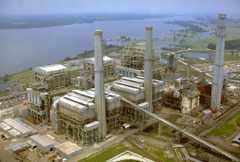
TXU Corp.’s Monticello Steam Electric Station is a lignite-fired power plant, named after nearby Lake Monticello, Texas. It is similar to those power plants currently planned for the area. (Courtesy of TXU Corp.)
As part of Living on Earth’s new series “Generating Controversy: The Changing Climate of Coal,” Living on Earth’s Jeff Young visits Texas to report on the dispute over a rush to build more than a dozen new coal-fired power plants. The Governor says they're needed to alleviate a coming crunch in power supply. But it's sparked a backlash from some unlikely opponents concerned about air quality and climate change.
Transcript
GELLERMAN: It’s Living on Earth. I’m Bruce Gellerman. The world’s appetite for energy seems insatiable and coal, cheap and plentiful, is increasingly being used to generate electricity. In the United States almost half of our electricity comes from burning coal and fast developing China already uses more coal than the United States, the European Union and Japan, combined.
But in addition to generating energy coal plants spew carbon dioxide, one of the greenhouse gases scientists say is warming the planet. This week, we launch a new series of occasional stories "Generating Controversy: The Changing Climate ofCoal."In the coming months we’ll look at the problems and promise of coal and the potential of new technologies.
Our first stop is Waco, Texas. Here, in the central part of the Lone Star state, Governor Rick Perry wants to build 11 new coal power plants to supply the electricity the region needs for the future. The governor’s plan is on a fast track for approval but faces stiff opposition from an unlikely coalition. From deep in the heart of Texas, Living on Earth’s Jeff Young begins our series on the battle over coal and climate.
[COWS MOOOING, CATTLE WALKING]
YOUNG: Some 40 Brangus cattle amble along the dry pasture and mesquite scrub of Robert Cervenka’s ranch. Cervenka’s looking for a calf with a makeshift bandage.
CERVENKA: See this calf over here? Other day I turned them onto oats and these cattle rushed into a pasture all at once and they broke his leg. So I put a splint on it. We wrapped it with duct tape and look how good he walks.
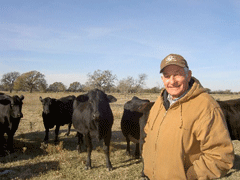
Robert Cervenka fears his ranch could soon be surrounded by three coal-fired power plants. The 76-year old rancher has helped organize opposition to the TXU plants out of concern for air quality and climate change.(Photo: Jeff Young)
YOUNG: Cervenka has lived on this ranch on the outskirts of Waco more than 60 years, and his father lived here before that. He belongs to the farm bureau, usually votes republican as many do here in McLennan County—President Bush’s ranch is just a short drive to the West.
YOUNG: (to Cervenka) I gotta tell you, you’re not what I think most people think of when they think of an environmentalist who’s gonna fight a power plant.
CERVENKA: Yes, I’m just an ordinary rancher. But I feel that, uh I probably was an environmentalist before there were environmentalists. We’re stewards of the soil we try to take care of our land and our cattle, our equipment, our family and everything else. We might not be out huggin’ trees but we’re real concerned about our land, our water, and our air. It’s our land, our lives.
YOUNG: What has Cervenka fired up is a proposal to bring coal-fired power to his part of Texas. Seventeen plants are proposed across the state and four could be built in McLennan County. Nearly any direction Cervenka looks from his ranch he could soon see smokestacks.

TXU Corp.’s Monticello Steam Electric Station is a lignite-fired power plant, named after nearby Lake Monticello, Texas. It is similar to those power plants currently planned for the area.(Courtesy of TXU Corp.)
YOUNG: (to Cervenka) So you could conceivably be walking out in your yard here and looking at 3 power plants right here?
CERVENKA: Yes, in fact we’ve been calling it the ring of fire. (Laughs) And not only that there’s, in the central Texas there’s six more proposed. We don’t understand why all at once we need all these power plants.
YOUNG: Cervenka helped organize some 180 local residents into a group called T-Power—Texans Protecting Our Water, Environment and Resources. They’re fighting a proposal by the company TXU power to quickly build 11 coal power plants. Those would replace some plants that burn natural gas. When gas prices rose sharply the Texas government put the TXU permits on a fast track that could shorten the legal process that normally takes more than a year to just six months.
JUDGE: Do you swear, or affirm, that the testimony you will give to be the truth, the whole truth and nothing but the truth?
CERVENKA: I do
YOUNG: At a hearing in Waco, Cervenka tells a judge he’s worried about the sulfur, particulate matter and mercury pollution the coal plants could bring.
CERVENKA: (on witness stand) My wife and I both have asthma, we both are cancer survivors. I see lots of things happening on the farm that concern me.
YOUNG: One by one, residents laid out their concerns about personal health, the local economy and about the global climate.
ANDERSON: Well, we have to look at the whole enchilada—that’s a local term here! Ha-ha.
YOUNG: Charles Doc Anderson, a Republican, represents McLennan County in the Texas House of Representatives. Anderson is among a growing group of Texas lawmakers who want to slow down the permitting process to more fully consider cumulative effects of the power plants, including the effects of carbon dioxide.
ANDERSON: CO2 is not currently by the EPA considered a pollutant, however, it will be, in time. I mean nationwide Texas has the largest footprint as far as CO2 production. I think our leaders would be seen in years to come as very progressive if we approach that right now at the get-go and start to worry about the CO2.
YOUNG: The proposed TXU plants alone would emit some 78 million tons of CO2 each year. That’s more than the total carbon emissions from some countries, like Portugal or Denmark. And it would swamp the carbon cuts California and some Northeastern states are working toward. TXU says projections of population growth and grid capacity show Texas needs the power, and fast.
MORGAN: We’re going to be facing a supply crunch come, starting in 2008. So we’re looking forward and we’re seeing we need to get some power plants built.
YOUNG: Company spokesperson Kim Morgan says new plants will replace some older ones and will have strict emissions controls, helping Texas reduce its notorious problems with air pollution.
MORGAN: TXU has voluntarily agreed to do a 20% reduction across our entire fleet in the emissions of key concern which are sulfur dioxide, known as SOX, nitrogen oxide, known as NOX, and mercury. So that’s a 500 million dollar retrofit program that we’re embarking on. So at the end of the day after all of these new units are built and on line, outwards in 2010 our emissions will actually be 20% lower than in 05.
YOUNG: But that’s not changing many minds at the hearing, where TXU’s opponents lined up with protest signs.
DARDEN: It says, ‘Waco: the black heart of Texas,’ with a coal stack there.
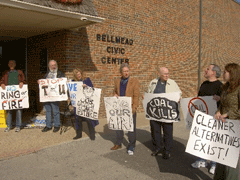
Fired up over coal-fired power, an unlikely coalition of ranchers,Republican politicians and local businesspeople are trying to put the brakes on the race to build new coal plants. These demonstrators spoke out at a hearing near Waco. (Photo: Jeff Young)
DARDEN: Well we don’t have coal plants right now in McLennan and we’re gonna have four. I don’t know how they’re doing their math but when you add four and you take away none, to me that’s an increase in emissions.
YOUNG: Others turned out in support of the power company. Ray Henderson sneers at the protesters.
HENDERSON: Oh, they don’t even know what they’re holding up there. They don’t have any idea about the signs that they’re saying and how that relates to real coal power production.
YOUNG: Henderson and Marlin Early work at a local power station equipment company.
HENDERSON: I think that the power plants, these coal plants they’re producing will be good for the economy and good for environment and good for the people who have to buy electricity.
YOUNG: Henderson and Early say their experience in the industry taught them that pollution controls work. And global warming? That’s not on their list of concerns.
EARLY: Well, you know, nobody can say for sure that we’re making global warming happen. For every scientist that believes there is, there’s one or two who believes there’s not.
YOUNG: But many others are concerned about climate change. Karen Hadden directs a group called SEED--sustainable energy and economic development. Hadden went on a ten-day hunger strike to protest coal power.
HADDEN: Certainly, we think the best answer is energy efficiency, renewable energy. Especially in Texas we should be rich from our sun and wind.
YOUNG: Hadden says the momentum toward action on global warming is what has TXU racing to build now.
HADDEN: TXU is definitely trying to skirt the regulations that they see coming and they know that the responsible thing to do would be to build cleaner plants if they’re going to build them and take their time and be more in line with these coming regulations. They’re trying to grandfather a whole generation of coal burning power plants in Texas before these regulations come through.
YOUNG: TXU spokesperson Morgan denies that.
MORGAN: Absolutely not! Again, what we know here today and what we’re basing our business decisions on is the fact that Texas needs more power.
YOUNG: Clearly with these power plants you would be putting out more carbon dioxide.
MORGAN: Clearly, but it’s a matter of scale. We have to keep in mind that Texas is actually the 11th largest electricity market in the world. We feel that the solution for carbon dioxide is technology. We firmly believe it’s coming, but it just isn’t there today.
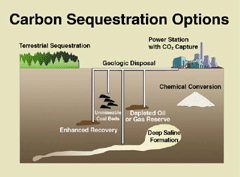
Carbon Sequestration is a still-unproven process by which carbon dioxide emissions are captured and kept out of the atmosphere, eliminating their ability to contribute to global warming. (Courtesy of the Department of Energy)
HOVORKA: We’re not waiting for a technology we don’t know about to be invented. The technology’s ready.
YOUNG: Geologist Sue Hovorka works with the Texas bureau of economic geology and a project called the gulf coast carbon center. She and her colleagues have been looking deep into the heart of Texas—about a mile deep—with sophisticated monitoring devices. Their six-million dollar project pumped carbon dioxide into the briny water and porous rock of an old oil field to see if it will stay where they put it.
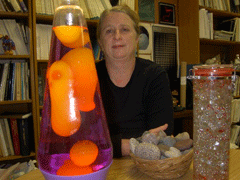
Geologist Sue Hovorka uses a lava lamp to mimic how CO2 moves in a semi-liquid form. Hovorka says underground carbon sequestration technology is ready. (Photo: Jeff Young)
YOUNG: Geologic sequestration is an important part of an ambitious, billion-dollar research effort by the US Department of Energy called FutureGen. The goal is a coal power plant with near-zero emissions. Last summer Department of Energy Assistant Secretary Jeff Jarrett announced that Texas is among the candidate sites to house the final FutureGen project.
JARRETT: The United States has a lot of coal and the world has a lot of coal and I believe that the world is going to use that coal and they’re going to be using that coal for decades to come. And we believe that when we are successful with FutureGen that it will set the gold standard for power generation not only in the U.S. but around the World.
YOUNG: What sets FutureGen apart from current coal power plants is that it would not burn coal—it would gasify coal. That makes the capture of carbon dioxide much easier. The gasification technology, called IGCC, has great promise. A few companies already use it and several others plan to. But the FutureGen power plant is still at least five years from starting. And its carbon capture technology would not apply to emissions from the existing style of power plants that burn coal, plants like the ones TXU wants to build.
ROCHELLE: We’re caught between the future and the here and now.
YOUNG: That’s University of Texas chemical engineering professor, Gary Rochelle.Rochelle is at work on ways to strip CO2 from those old fashioned coal-burning plants.
ROCHELLE: This is one of my research laboratories.
[BUZZING OF EQUIPMENT]
YOUNG: Rochelle walks me through a miniature version of the system that could take CO2 from a power plant’s exhaust. Carbon dioxide pumps through a container of an aqueous solution.
ROCHELLE: In the aqueous solution there’s an organic molecule that we call an amine, it’s got a nitrogen bonded to a carbon and it acts like a base. And carbon dioxide is a weak acid. So it’s kind of an acid base reaction.
YOUNG: So imagining something like this on a very big scale.
ROCHELLE: So you have to really use your imagination. If you use your imagination you see that piece of metal about the size of a finger—and that’s what we use in the laboratory. The liquid runs down the wall of that. And then gas runs beside it. And we measure how much CO2 transfers from the gas to that wet wall. And wet walls like that are exactly what’s inside the big 50 foot diameter scrubber, there’s just a whole bunch of those wet walls. We want to pack as many of em’ as we can because the more wall we have the better the CO2 will absorb.
YOUNG: The amine capture technology is not new, Rochelle is just improving the chemistry to make it more practical on a large scale. He says that could happen by the year 2015. It would not be easy or cheap. It would require a large apparatus at each power plant and would use from 20 to 30 percent of the power to operate.
ROCHELLE: It’s expensive, it takes a lot of energy. Nobody wants to do it. But it’s the technology we’ve got. And in my opinion it’s the technology we’re going to have in the year 2030. And there’s no federal government funding to work with the problems that this technology has.
YOUNG: (to Rochelle) What do you think it would take to get, you know, the company that runs an existing coal-fired power plant to adopt this technology which is going to take up a lot of space? I’m guessing it would be pretty costly - what would it take for companies to be interested in the kind of technology that you’re developing?
ROCHELLE: Quite literally it takes an act of congress. The answer is technological but it needs a law. Voluntary enforcement or adoption of this technology is not going to happen to any major extent.
[SOUNDS OF CATTLE MILLING ABOUT]
YOUNG: Meanwhile, back on the ranch, Robert Cervenka kicks at the dusty ground and wonders if climate change is already at work in the form of a deep drought.
CERVENKA: This is three or four years we’ve had it already and it’s gettin’ pretty dang serious. In the 50s we had a terrible drought but this is about as bad as they come here. We have some stock ponds I haven’t seen dry in my lifetime that are now without water.
YOUNG: He says it’s as if the arid region is spreading. He worries about what burning more coal will do.
CERVENKA: Well I’m 76 years old it doesn’t matter to me. Before these power plants probably affect me I’ll be gone. But I have nine grandchildren and I got two sons and two daughters, I’d like to leave this place a little better than I found it.
[DISTANT MOOING]
YOUNG: For Living on Earth, I’m Jeff Young in Waco, Texas.
Links
TXU Corp page on new power plants
Environmental Defense on TXU power and climate change
Department of Energy’s FutureGen Project
Living on Earth wants to hear from you!
Living on Earth
62 Calef Highway, Suite 212
Lee, NH 03861
Telephone: 617-287-4121
E-mail: comments@loe.org
Newsletter [Click here]
Donate to Living on Earth!
Living on Earth is an independent media program and relies entirely on contributions from listeners and institutions supporting public service. Please donate now to preserve an independent environmental voice.
NewsletterLiving on Earth offers a weekly delivery of the show's rundown to your mailbox. Sign up for our newsletter today!
 Sailors For The Sea: Be the change you want to sea.
Sailors For The Sea: Be the change you want to sea.
 The Grantham Foundation for the Protection of the Environment: Committed to protecting and improving the health of the global environment.
The Grantham Foundation for the Protection of the Environment: Committed to protecting and improving the health of the global environment.
 Contribute to Living on Earth and receive, as our gift to you, an archival print of one of Mark Seth Lender's extraordinary wildlife photographs. Follow the link to see Mark's current collection of photographs.
Contribute to Living on Earth and receive, as our gift to you, an archival print of one of Mark Seth Lender's extraordinary wildlife photographs. Follow the link to see Mark's current collection of photographs.
 Buy a signed copy of Mark Seth Lender's book Smeagull the Seagull & support Living on Earth
Buy a signed copy of Mark Seth Lender's book Smeagull the Seagull & support Living on Earth

